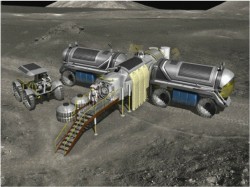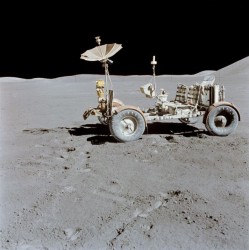NASA is exploring the possible designs for lunar bases, intended for an extended stay on the Moon. A NASA official from the Advanced Capabilities Division also said on Friday that they may be inspired by a concept based on the technology of the International Space Station (ISS). Very little official indication about the future of NASA’s lunar policy has come to light, so this is interesting news. Although the statement was suitably sketchy, a six-month extended mission to the Moon seems to be most likely. How does this development compare with the lunar settlement designs already proposed?
When Carl Walz, director of NASA’s Advanced Capabilities Division, says “I would anticipate that we would build something similar as what we are building for the ISS, but maybe something different,” I think we can conclude that his department is keeping its options open as far as the future of Moon bases is concerned. But it seems settlement design isn’t very far along either…
Putting uncertainties in lunar base designs to one side, Waltz did confirm that he envisions a long-term, six-month stay over on the Moon, “We need to establish a long, extended presence on the moon, up to six months — same as the time we spend at ISS,” the veteran astronaut told AFP during a forum on the future of NASA at the University of Miami, Florida. The ISS remains mankind’s best experiment into long-term living in space, so its little wonder the station should be used as a model for Moon bases.
The ISS is due for completion in 2010 and houses three scientists for several months at a time. Also, there is enough room for the regular Shuttle crews who arrive to deliver experiments and attach modules. It’s not hard to imagine a future manned lunar base can be used in a similar way, perhaps have a small long-period contingent of scientists, allowing space for short-term visits.
NASA hopes to return to the Moon by 2020 to build a permanent outpost on our planet’s natural satellite. The settlement will need transportation, communication and power systems (see Building a Base on the Moon: Part 4 – Infrastructure and Transportation), allowing lunar astronauts to have the freedom to carry out scientific research on the lunar surface. Many lunar base concepts utilize local materials to fabricate many aspects of a permanent lunar habitat, and continued research by satellites such as the Japanese probe SELENE will aid future colonists prospect for useful minerals and ores.
“We will live at the moon, work at the moon, do sites at the moon and use its resources.” – Walz
It looks as if NASA is working toward a modular settlement design, using the technology that powers the ISS and would be in keeping with “erectable”, or modular designs. Initially, building Moon bases on Earth (or low Earth orbit) and sending them to the lunar surface appears to be the most viable solution. Once a human presence can be established on the Moon, it seems possible that Mars habitats could be fabricated there and sent to the Red Planet. Exciting times.
More about building a manned base on the Moon:
- Building a Base on the Moon: Part 1 – Challenges and Hazards
- Building a Base on the Moon: Part 2 – Habitat Concepts
- Building a Base on the Moon: Part 3 – Structural Design
- Building a Base on the Moon: Part 4 – Infrastructure and Transportation
Source: Physorg.com




I remember being in grade school and reading how we would have a moon base in 1998.
Also, wouldn’t a long-term stay on the moon be hazardous to the body when taking into consideration cosmic radiation?
The dust would kill you before the radiation.
I nominate the entire Bush Administration for the first long term lunar deployment.
There’s quite a big jump between spending six month periods on the ISS and the Moon. Each has its own risks and dangers, however, both need necessary infrastructures — safety from radiation, habitable space, reasonable accessibility to Earth…etc., — that I’m sure NASA are building into future designs.
On a personal note, I think that I would much rather live/work on the Moon than on the ISS for the proposed six-monthly period, as there are more options — wider environment to explore, 1/6 gravity over zero gravity is better, more protection …etc., — one could take advantage of.
John — http://www.moonposter.ie
Walz and NASA in general, read too many sci-fi books. Mankind is technically more than a century or two away from an extended stay on the moon or, for that matter, anywhere else in the solar system. Considering the direction the world economy is headed, there simply will not be enough G8 votes for the hundreds of billions of dollars needed to finance space travel.
Hi Justine,
You’re right! Where are all the “sign me up now” space enthusists? There is always a degree of pessimism with these topics. But I agree with John, a six month stay on the Moon would be far more enjoyable than the ISS (although I wouldn’t mind a couple of weeks!),
Cheers, Ian
That was not very nice Wheel of Fire. I guess every comment section has to have it’s own fools.
Wow aren’t we just a bunch of optimists?
(4.0 × 1015) This is the current value of the estimated one million tons of helium-3 at $4billion a ton to be strip mined on the lunar surface. This is the financial incentive behind this race to the moon.
Justine, It’s difficult to be optimistic with an ego driven government agency developing a six month science station on the moon. The logistic problems are literally impossible with today’s technology. Extended stays on the moon will eventually happen, but.I don’t think it will be in our life times or even this century. My money would be on the Branson group rather then NASA to be the first to do six months on the moon.
NASA can do this, and in the timeframe listed (Is that enough optimism for you?). There is nothing technical that we can’t overcome with our current technology. Most of what we’ve learned on Apollo and the ISS will be applicable and very helpful to survive on the moon for six months. It’s not too much different, if you over simplify everything. The moon dust won’t kill them. Radiation won’t kill them. And I’m not sure exactly why it would take a century or two to develop the technology that we’re speaking about here. Unless you’re referring to cities on the moon and such. A research base won’t be too much of a leap. Even the cities, the only thing required is cash. There’s obviously not enough will for governments or corporations to build cities on the moon. And, yes, the science station may be underfunded, and not be what we need to make it truly valuable. However, I think it will happen.
Honestly, I think the same thing will happen here as what happened to the ISS. We’ll see a downgraded version, over budget. And it will be ten years late. But I think it will happen.
Unless the next administration kills it. And even then, I think it will just be a delay, as the Ares I and Orion WILL be built, regardless of what the next administration does. All you need then is either an Ares V, or multiple launches with the Ares I.
As long as someone high up wants to do it (believe me, NASA DOES want to do this), it will happen in some way.
The next 20 years in spaceflight should be very interesting. Hopefully it will be exciting as well.
It seems to me instead of burning up the Jules Vern craft to find a why to have this extremely large and expensive vehicle to orbit the Moon. When we finally get there the vessels can be brought down from orbit and they are then used to construct the housing needed for the Lunar experience. Take about the ultimate recycle use!!
To Eric Conrad, Show me a successful self contained totally isolated six month biosphere project here on earth and I might then share some of NASA’s optimisim about an extended multi-month stay on the moon. Included in this theatrical earth project, NASA can only transport all the stuff.planned for this moon station in a vehicle about the size and shape (on an 18 wheel flat-bed truck) that will travel to the moon, orbit and land. If NASA can do a successful earth based biosphere without intervention, then I might concide the moon dream is a possibility in less than a century.
The NASA people are taking everything step by step, validating and then stretching the technology, just as they did the first time they went to the moon. That’s the way you do it.
Sign me up. Especially if it puts me first in line for the Mars mission!